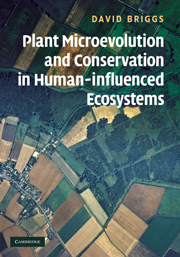Book contents
- Frontmatter
- Contents
- Preface
- Acknowledgements
- List of abbreviations
- 1 Introduction
- 2 Studying change
- 3 Key concepts in plant evolution
- 4 The origin and extent of human-influenced ecosystems
- 5 Consequences of human influences on the biosphere
- 6 Categories
- 7 Investigating microevolution in plants in anthropogenic ecosystems
- 8 Plant microevolution in managed grassland ecosystems
- 9 Harvesting crops: arable and forestry
- 10 Pollution and microevolutionary change
- 11 Introduced plants
- 12 Endangered species: investigating the extinction process at the population level
- 13 Hybridisation and speciation in anthropogenically influenced ecosystems
- 14 Ex situ conservation
- 15 In situ conservation: within and outside reserves
- 16 Creative conservation through restoration and reintroduction
- 17 Reserves in the landscape
- 18 Climate change
- 19 Microevolution and climate change
- 20 The implications of climate change for the theory and practice of conservation
- 21 Overview
- References
- Index
20 - The implications of climate change for the theory and practice of conservation
Published online by Cambridge University Press: 05 June 2012
- Frontmatter
- Contents
- Preface
- Acknowledgements
- List of abbreviations
- 1 Introduction
- 2 Studying change
- 3 Key concepts in plant evolution
- 4 The origin and extent of human-influenced ecosystems
- 5 Consequences of human influences on the biosphere
- 6 Categories
- 7 Investigating microevolution in plants in anthropogenic ecosystems
- 8 Plant microevolution in managed grassland ecosystems
- 9 Harvesting crops: arable and forestry
- 10 Pollution and microevolutionary change
- 11 Introduced plants
- 12 Endangered species: investigating the extinction process at the population level
- 13 Hybridisation and speciation in anthropogenically influenced ecosystems
- 14 Ex situ conservation
- 15 In situ conservation: within and outside reserves
- 16 Creative conservation through restoration and reintroduction
- 17 Reserves in the landscape
- 18 Climate change
- 19 Microevolution and climate change
- 20 The implications of climate change for the theory and practice of conservation
- 21 Overview
- References
- Index
Summary
Conservation efforts aim to prevent the extinction of endangered species and to provide them with a long-term evolutionary future. In 2000, a colloquium of the National Academy of Sciences of the USA, meeting in Irvine, California, considered ‘The biotic crisis and the future of evolution’ (papers given at the meeting were published in Proceedings of the National Academy of Sciences, USA, 98, 2001). Myers and Knoll (2001, 5389), speaking at the meeting, concluded that ‘human activities have brought the Earth to the brink of biotic crisis’ and ‘in decades to come a large number of species will be lost’. This pessimistic assessment was echoed by many others at the colloquium. It is significant, however, that, while several speakers mentioned climate change, they did not highlight it as a major issue. In less than a decade, there have been major advances in our understanding. As we shall see in this chapter, anthropogenic climate change presents a dramatic and potentially catastrophic threat to the world's biodiversity with profound implications for the theory and practice of conservation.
Doubts about modelling
Some naturalists, accustomed to a life outdoors, are antagonistic to the study of ecological/conservation issues through computer modelling, and doubt the value of such studies in the prediction of future trends. However, it is important to accept that modelling provides important helpful insights that cannot be obtained by any other means. While acknowledging the limitations of models with their simplifying assumptions, it would be foolish not to take their conclusions seriously.
- Type
- Chapter
- Information
- Publisher: Cambridge University PressPrint publication year: 2009



